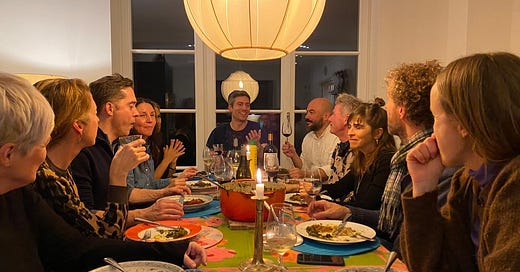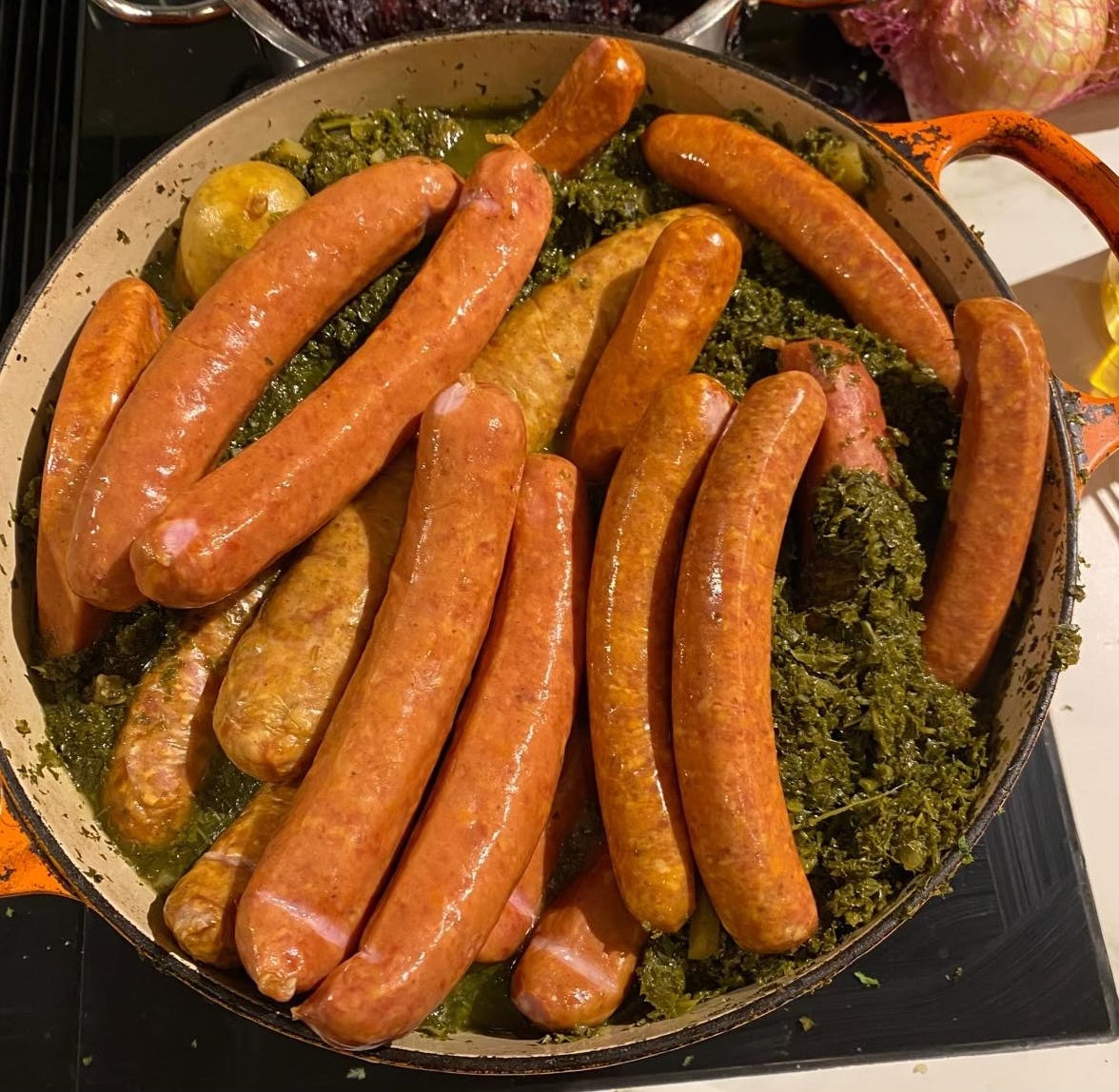Today, less than two months from the pub date for Classic German Cooking, I’m launching a new limited series here, namely interviews with lovely friends and people about classic German food and their relationship to it. When you write a cookbook (or two) about German cooking, almost everyone you meet will have an opinion about their favorite German recipes. In the run-up to publication, I thought it’d be fun to talk to friends and acquaintances in Berlin and beyond, and maybe even get a bonus recipe here or there, if someone’s generous enough to share. If you’re a passionate cookbook reader like me, you know that the stories around food are often at least as interesting, if not more, than the food itself. And I’m always especially intrigued by non-Germans’ feelings about German food after living here for a while.
To kick things off today, I’m interviewing my friend Jiffer Bourguignon, who lives in Hamburg with her husband Ingo and their three children and throws enviable expat Thanksgiving parties.
Hey Jiff! To start, could you introduce yourself?
My name is Jiffer Bourguignon. I am an American who has been living in Hamburg on and off for a long time, most recently for the past 8 years. I am an editor and originally from Wisconsin.
What brought you to Germany or to Hamburg specifically?
It is one of those typical love stories: I met someone in the U.S. and we had a very long—nine-year-long—distance relationship and then we got married and then we had another year-and-a-half long-distance relationship - and then I finally agreed to give Hamburg a shot.
Your husband is half-German, half-Italian, is that right?
That's right.
And so was your first introduction to German food via his German family?
Yes, they’re from the Rheingau region; his mother is from Bingen and he grew up in Wiesbaden.
Do you have any memories of the first time you were in Germany eating German food, was it something that was comforting and familiar to you from your upbringing in the Midwest or were you sort of like, whoa, what is this?
There were definitely lots of similarities in terms of the Midwest, like so many potatoes! In the Midwest, there are a lot of Americans with German, Polish or Scandinavian backgrounds. One of the first meals [in Germany] that I can remember was when I was spending Christmas with my husband and his family and we had the traditional roast goose with Rotkohl (red cabbage) and Klöße (potato dumplings) and I just absolutely fell in love with everything. The meat was so much richer than turkey meat, the Rotkohl, oh, just the tang of it, and the Klöße were so big and pillowy. I mean, so delicious. His family was a little nervous and said, well, let us explain this meal to you, but I think I had finished my plate before they were even done talking.
One thing that has completely stuck in my memory of conversations with you about food is that years ago you mentioned to me that you were a huge fan of Labskaus; is that still the case? [Ed. note: Labskaus is a specialty of Hamburg, a port city on the Elbe River, and consists of cooked corned beef, boiled potatoes and cooked beets mashed together, then served with pickled herring and a fried egg on top. It was concocted by sailors who cooked with ingredients that didn’t require refrigeration and could keep for the duration of the trip].
It's not one of those things that I necessarily eat very often, but if it’s on the menu somewhere, then I always see it as a special treat. I know it's kind of a weird combination, but you know—speaking of Midwestern ancestors—my mother has German ancestry and one of her grandmothers made a dish that she called Labskass and it was basically the same thing: a corned beef hash with beets and a pickled herring on top.
Okay, so it was in your culinary DNA!
It was! My mom never made it, she just recalled that her grandmother would make it. But as a kid she thought it was disgusting and that's why she never made it for me. So I had never tried it until, one day, Ingo and I were at a little place here in Hamburg called the Oberhafen Kantine and they had it on the menu, so I tried it and fell for it. Incidentally, the Oberhafen Kantine is in the port of Hamburg, where dockworkers would traditionally stop in the morning for a breakfast snack and a cup of coffee. One of the snacks was a little meatball, they called it a Rundstück, so when traffic was coming in through the harbor from abroad, people found these little meatballs and called them hamburgers. I’m not sure if that’s really the origin of the name, but that’s what people here tell me!
Do you ever cook German food at home?
I do! One of my favorites in the German culinary arsenal is white asparagus with Hollandaise and ham and potatoes. I love it so much and I make it many times from April through June every year. Our kids don’t love it, but Ingo and I do—we only disagree on the consistency of the asparagus. I like to cook them until they still have a bit of bite, because soggy asparagus is an absolute no-no for me, but he likes them a little more cooked. The trick to boiling white asparagus is to add butter, sugar and salt to the boiling water when you cook them.
Oh yeah? I’ve never heard of that!
Yup! A little butter, sugar and salt. I used to serve white asparagus with the Thomy Hollandaise sauce from a box, haha, but when I learned to make Hollandaise myself it was such a revelation. I’ll never go back to the box! The only bummer is now I know how much butter goes into it.
Another thing I love to make is Grünkohl (curly kale). On one of my first trips to Hamburg, back when Ingo was doing a traineeship at the local television station, he had to spend 6 weeks in Oldenburg with another colleague. At some point during the trip, they were invited to a Kohlfahrt [a local tradition of playing games in cabbage fields with lots of participants] and I went along. It was freezing cold and I was like, what the hell is this? We went into the fields with these red radio flyer wagons and we’d play funny kid games, like people would stand across from each other and throw a ball back and forth, and the television team would take a shot and then, you know, we’d walk for another 15 minutes, and then there’d be another game and another shot and that went on until the end of the day. Afterwards, we went back to a Kneipe (bar/restaurant) where someone had been cooking a huge pot of Grünkohl (curly kale) all day long with Pinkel (a local type of smoked sausage that is made with pork and groats) and you’re freezing cold and a little tipsy and it’s the best thing you’ve ever tasted. I’m working on starting a tradition like that with some friends here in Hamburg.
In Germany, they sell 1 kg bags of curly kale for two or three euros, the best deal ever. I‘ll eat it raw as a salad, but I’ve been warned by several German friends that “you can’t eat it raw!“ They would never think of eating raw kale! Also, we do a big Thanksgiving, which [like many Americans in Germany] we celebrate on the Saturday after Thanksgiving and lots of friends will come to town for it, so on the Friday night before, I‘ll make a big, big pot of Grünkohl. A nice light meal before our Thanksgiving feast…ha!
Jiffer Bourguignon’s Grünkohl mit Pinkel
Curly Kale with Sausages
Serves 4-6
There are many recipes for Grünkohl, some simpler, some more elaborate, but I’ve settled on this one, which includes apple cider vinegar. The acidity gives the dish a good lift and balances the heaviness of the sausage and Schmalz. Grünkohl is great for a group, can be done a day in advance (just wait to add the sausages to the pot as you’re warming it up to cook them—and make sure they’re cooked through before serving), and is especially warming on a cold winter day. Typically, this is eaten in Germany only after the first frost, usually mid-November. It is accompanied by beer mainly, but works well with a crisp white or red wine and is digested afterwards with some schnapps. I like Williams Birne. Basically, whatever you prefer!
1 kg fresh curly kale
4 small potatoes, peeled and finely diced
4 small/medium onions, finely diced
4 Tbsp Gänseschmalz/goose fat (alternatively. duck fat)
1/2 cup diced Speck (bacon)
1 sour apple, peeled and finely diced
1 cup apple cider vinegar
1-2 sausages per person, for example bratwurst or Italian sausage
Salt and pepper
1. Wash, de-stem and finely chop the kale (or make your life easy and blitz it in a food processor).
2. Blanch the kale in salted water for 30 seconds and drain well. Try to squeeze the water out as much as possible. (To be honest, sometimes I skip this step and I think it still works. Just add a bit more water in Step 4: a cup rather than half).
3. Put the goose fat, onions, potatoes, Speck and apple in a large pot and cook on medium heat for 10 minutes.
4. Add the kale, stir well to combine, then add 1/2 cup of vinegar and 1/2 cup of water. Cover and cook over medium to medium-low heat, stirring every 20 minutes, for an hour.
5. After an hour, add another 1/2 cup of vinegar and salt and pepper to taste. Cover and cook for another 30 minutes.
6. Lay sausages on top of kale and cover. Taste and add more vinegar if you want a little more tang. Cook another 20 to 30 minutes.
7. Taste the kale—if it needs more seasoning, adjust to taste.
8. Serve with small boiled peeled potatoes and strong mustard.





This is beautiful! As an avid cookbook reader and lover of cooking/baking/food in general, I'm always captivated by the stories around food. In fact, they make me emotional. I have a German father and a Croatian mother (both of whom love to cook and bake), so food, and the associated people and stories, has always played a central role in our family life.
I look forward to more of these stories in anticipation of Classic German Cooking!
I loved this! I also add sugar, salt and butter when cooking white asparagus, but I make a stock from the peelings first and add them to that with the spears. Looking forward to more of these interviews - and even more so of course the publication of your book! Liebe Grüße from down here in sticky Rheinhessen